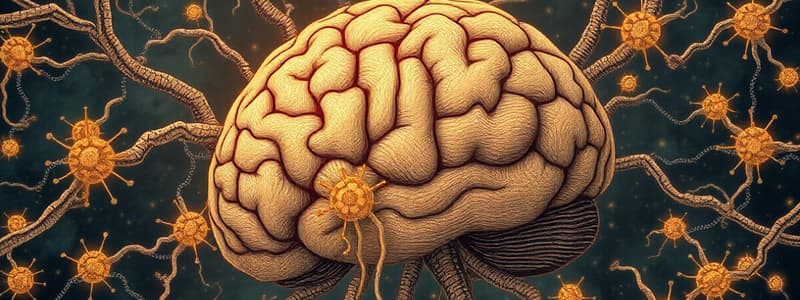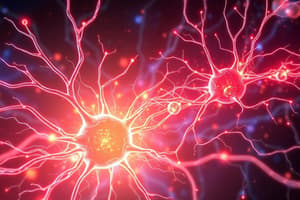Podcast
Questions and Answers
How does the specialization of neurons by location primarily enhance brain function?
How does the specialization of neurons by location primarily enhance brain function?
- By enabling different brain regions to process specific types of information more efficiently. (correct)
- By increasing the overall size of the brain to accommodate more neurons.
- By preventing the formation of new neural connections, thus maintaining the stability of brain circuits.
- By reducing the energy consumption of the brain, as specialized neurons require less energy.
What is a key structural difference between Purkinje cells and pyramidal cells that reflects their distinct functions?
What is a key structural difference between Purkinje cells and pyramidal cells that reflects their distinct functions?
- Purkinje cells are sensory neurons, whereas pyramidal cells are motor neurons.
- Purkinje cells possess elaborate, bush-like dendrites, while pyramidal cells have a triangular cell body and a long dendrite. (correct)
- Purkinje cells are located in the cerebral cortex, while pyramidal cells are found in the cerebellum.
- Purkinje cells have a single axon, while pyramidal cells have multiple axons.
Why is the myth 'we only use 10% of our brains' considered false by neuroscientists?
Why is the myth 'we only use 10% of our brains' considered false by neuroscientists?
- Because the other 90% is used for complex processes that scientists cannot yet measure.
- Because neuroimaging studies show that more than 10% of the brain 'lights up' during any given task.
- Because the myth originated from misinterpreting Albert Einstein's explanation of his intellect.
- Because the entire brain is active to some degree, and unused neurons tend to die or atrophy. (correct)
What evidence contradicts the claim that enriching a child's environment beyond what is typical significantly boosts cognitive development?
What evidence contradicts the claim that enriching a child's environment beyond what is typical significantly boosts cognitive development?
What critical thinking skills should be applied when encountering claims about the brain, such as the '10% myth'?
What critical thinking skills should be applied when encountering claims about the brain, such as the '10% myth'?
If someone claims that they can improve their cognitive function significantly by using brain-training apps for a few hours each day, what should you ask to apply critical thinking?
If someone claims that they can improve their cognitive function significantly by using brain-training apps for a few hours each day, what should you ask to apply critical thinking?
How do neuromyths persist despite scientific evidence disproving them?
How do neuromyths persist despite scientific evidence disproving them?
If a teacher believes that students learn better when taught using their preferred learning style (auditory, visual, kinesthetic), what is the primary problem with this belief?
If a teacher believes that students learn better when taught using their preferred learning style (auditory, visual, kinesthetic), what is the primary problem with this belief?
What could be the problem with research that shows only a small number of brain areas 'lighting up' in a brain scan?
What could be the problem with research that shows only a small number of brain areas 'lighting up' in a brain scan?
Why might teachers who know more about neuroscience still believe in neuromyths?
Why might teachers who know more about neuroscience still believe in neuromyths?
How might the belief that enriching children's environments strengthens their brains be a misinterpretation of rat studies?
How might the belief that enriching children's environments strengthens their brains be a misinterpretation of rat studies?
What is the main reason that eradicating neuromyths from popular consciousness is such a difficult task?
What is the main reason that eradicating neuromyths from popular consciousness is such a difficult task?
Which statement best describes the difference between how bipolar cells, Purkinje cells, and pyramidal cells are specialized?
Which statement best describes the difference between how bipolar cells, Purkinje cells, and pyramidal cells are specialized?
What fundamental assumption underlies the 'learning styles' neuromyth that is not supported by scientific evidence?
What fundamental assumption underlies the 'learning styles' neuromyth that is not supported by scientific evidence?
What is the best approach to counteract the spread of neuromyths, according to the information provided?
What is the best approach to counteract the spread of neuromyths, according to the information provided?
If someone states that 'Environments rich in stimuli improve the brains of preschool children' what should you consider?
If someone states that 'Environments rich in stimuli improve the brains of preschool children' what should you consider?
Imagine a friend tells you that they can tell when someone is staring at the back of their head. How should you respond, based on the principles of critical thinking?
Imagine a friend tells you that they can tell when someone is staring at the back of their head. How should you respond, based on the principles of critical thinking?
Which of the following is an example of how neurons are specialized based on their location?
Which of the following is an example of how neurons are specialized based on their location?
What is the importance of identifying and dispelling neuromyths in the field of education?
What is the importance of identifying and dispelling neuromyths in the field of education?
How might neuromyths negatively affect the public's understanding of neuroscience?
How might neuromyths negatively affect the public's understanding of neuroscience?
Flashcards
Purkinje Cells
Purkinje Cells
Interneurons carrying information from the cerebellum; have dense, elaborate, bush-like dendrites.
Pyramidal Cells
Pyramidal Cells
Neurons in the cerebral cortex with a triangular cell body, one long dendrite, and many smaller dendrites.
Bipolar Cells
Bipolar Cells
Sensory neurons in the retina with a single axon and a single dendrite.
10% Brain Myth
10% Brain Myth
Signup and view all the flashcards
Environment Enrichment Myth
Environment Enrichment Myth
Signup and view all the flashcards
Learning Styles Myth
Learning Styles Myth
Signup and view all the flashcards
Critical Thinking
Critical Thinking
Signup and view all the flashcards
Study Notes
- Neurons can be specialized based on location for sensory, motor, or connective functions.
Neuron Examples
- Purkinje cells are interneurons that transmit information from the cerebellum to the rest of the brain and the spinal cord; they feature dense, elaborate, bush-like dendrites.
- Pyramidal cells are found in the cerebral cortex, have a triangular cell body, and possess a single, long dendrite among many smaller dendrites.
- Bipolar cells are sensory neurons in the retinas, characterized by a single axon and a single dendrite.
- Specialization at the cellular level evolved within the brain to process different types of information.
Neuromyths
- Neuromyths are misconceptions about the brain that lack scientific support.
- The idea that "we only use 10% of our brain" is a pervasive myth.
- The entire brain is used; unused neurons die and unused circuits atrophy.
- Neuroimaging research may show only a small number of areas "lighting up", but those are just areas that have more than a baseline level of activity.
- The belief in the 10% myth was found in 47% of teachers in the Netherlands and the United Kingdom.
- 76% of teachers also thought enriching children's environments would strengthen their brains.
- The belief that enriching children’s environments will strengthen their brains comes from experiments on rats raised in enriched cages.
- These experiments showed that rats in cages with amenities like exercise wheels, tunnels, and other rats, showed better cognitive abilities and improvements in brain structure compared with rats that grew up isolated in bare cages.
- However such experiments only show that a truly impoverished and unnatural environment leads to poorer developmental outcomes than a more natural environment.
- 94% of teachers believed students perform better when lessons are delivered in their preferred learning style.
- Students do have preferences in how they learn; the problem is that these preferences have little to do with how effectively they learn.
- Surveys have found that about two-thirds of the U.S. public agreed with the 10% myth.
- Many also believed that memory works like a video recording or that they can tell when someone is staring at the back of their head.
- Teachers who knew the most about neuroscience also believed in the most myths.
- Claims should be met head on with critical thinking.
Studying That Suits You
Use AI to generate personalized quizzes and flashcards to suit your learning preferences.




